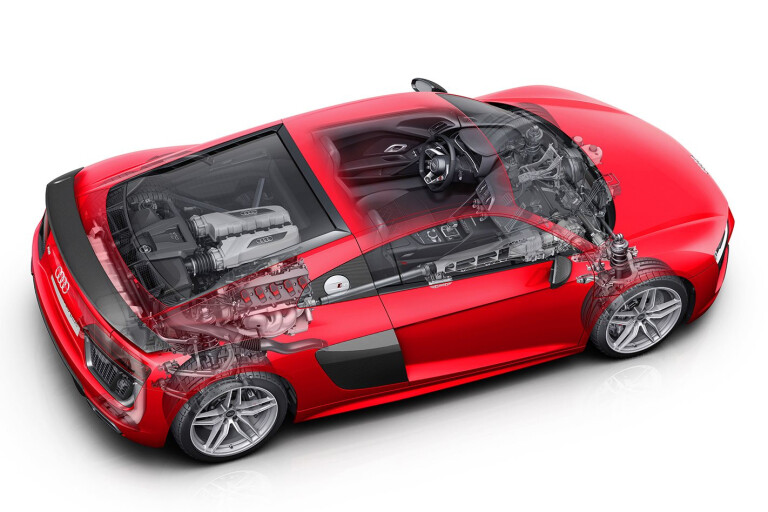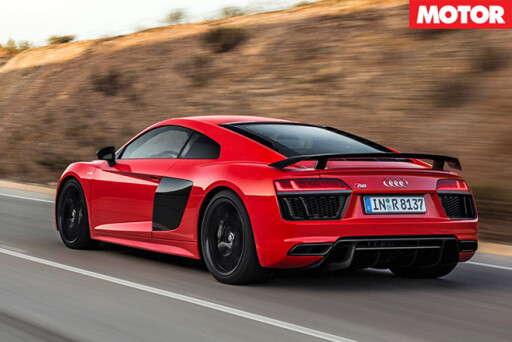
IN SIMPLER times, economy was what economy cars were for. Supercars, well, they were garage ornaments for the wealthy, built for boulevard posing. Collectively, they probably used less petrol than the world’s Corollas.
Regardless, conspicuous consumption (of fuel, not money) in fast wedge-shaped machines has long been on the nose – and in the crosshairs of environmental regulators. The 40-plus-million Corollas on the roads continue to get away with it.
This means that sometime in the past decade or so, the supercar and the economy car became one.
Audi, for example, was able to cut the R8 V10’s thirst by 13 per cent in the update to the current model, which uses 11.4L/100km on the combined cycle. (In its defence, Corolla consumption dropped by 25 per cent in a similar timeframe).
If we’re sounding a bit cynical about saving fuel in supercars, we’re actually all for road-going efficiency enhancements (don’t get us started on F1).
 In fact, as people who like to drive supercars, the idea of a weapon-fast machine that uses as little fuel as possible (still a lot), without much perceptible eco-affectation, is great. As is the reality. The pillars of saving fuel are chiselled in stone, but some of the ways Audi engineers have done it in the R8 are pretty cool.
In fact, as people who like to drive supercars, the idea of a weapon-fast machine that uses as little fuel as possible (still a lot), without much perceptible eco-affectation, is great. As is the reality. The pillars of saving fuel are chiselled in stone, but some of the ways Audi engineers have done it in the R8 are pretty cool.
Let’s start with weight – that’s where Ingolstadt started when they sketched up the second-gen Audi Space Frame supercar.
A monocoque made of aluminium front and rear sections, tied by a largely carbonfibre-reinforced-plastic occupant cell, wrapped in aluminium panels and underpinned by aluminium suspension control arms and forged wheels, keeps the weight of the R8 about the same as an S3.
The engine’s die-cast aluminium block contributes too, but the real cleverness lies inside the ECU.
A combination of direct injection into the cylinders and port injection in the intake manifold lift thermodynamic efficiency, by ensuring cool cylinder walls and a high charge concentration.
Under low and intermediate loads, the big V-engine reverts to a slant-five, seamlessly shutting off one cylinder bank and then the other, by cutting fuel and spark.
 While you're cruising at speeds less than 55km/h, blissfully unaware you’re being pushed by only one more pot than in the average hatch, the R8’s seven-speed dual-clutch will surreptitiously decouple its clutches to freewheel, conserving both fuel and kinetic energy.
While you're cruising at speeds less than 55km/h, blissfully unaware you’re being pushed by only one more pot than in the average hatch, the R8’s seven-speed dual-clutch will surreptitiously decouple its clutches to freewheel, conserving both fuel and kinetic energy.
Go to pose and the automatic stop-start system is way ahead of you, shutting off the engine quicker than you can double-park.
But there’s one area in which an R8 remains off the pace of the average eco-car: aerodynamic drag (Prius Cd 0.26; R8 0.36).
It’s not that Audi hasn’t given the R8’s aero due attention. For all the greenery, it’s still a supercar and has to balance slipperiness with delivering 140kg of downforce at 330km/h.
Every little bit
5 tricks saving 0.6L/100km
1. INJECTION STRATEGIES
At low load the V10 is port fuel-injected (MPI). A mix of MPI and direct injection into the cylinders (FSI) takes place under moderate load. The FSI transitions to 85 per cent at max load, which cools the cylinder walls while the MPI contributes to charge-density.
2. PART-TIME FIVE-POT
At low and intermediate load in fourth through seventh gears, the cylinder deactivation system shuts down a bank of five cylinders at a time. If the deactivation phase is longer than 30 to 60 sec, the COD imperceptibly alternates cylinder banks in three tenths of a second, to keep the catalytic converter in each header pipe at operating temp
3. COASTING MODE
In comfort mode in the R8’s Audi Drive Select system, at speeds under 55km/h, the seven-speed dual-clutch decouples both its clutches to switch to freewheeling operation whenever the driver’s foot comes off the accelerator. The engine keeps burning fuel rather than going into deceleration cut-off, but the R8 keeps its hard burnt momentum.
4. NAP MODE
While stop-start didn’t contribute to the official economy figure – the test doesn’t include a traffic-jam element – it’ll save more than a slurp in the modern supercar’s natural environment of urban rush-hour.
5. SLIPPERY SHAPE
The R8's double-bubble rear window calms airflow over the car, while a smooth underbody cover and diffusers in the front wheel arches and underneath at the back reduce turbulence. A powered rear wing on the R8 V10 Plus cuts low-speed drag before being deployed above 120km/h for 40kg front/100kg rear downforce at its 330km/h Vmax.
 Set to stun
Set to stun
Keen on 0.0L/100km?
If you’re thinking some of the R8’s efficiency-enhancing measures could be those of a dedicated green machine rather than a supercar, so was Audi, delivering both in its R8 e-tron. Not that the idea of a hybrid or electric supercar is new. It’s today more difficult to find exotica without an AC motor than with. Twinned electric motors with a combined 340kW and 920Nm fire the e-tron from 0-100 km/h in 3.9sec and on to a top speed of 250km/h, with a max range of 450km thanks to high-power, high-energy-density batteries.

COMMENTS